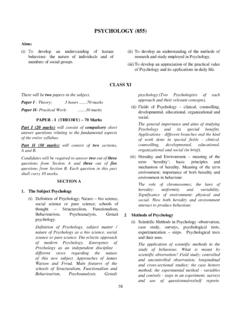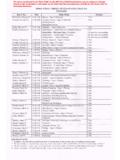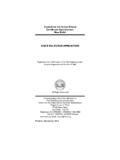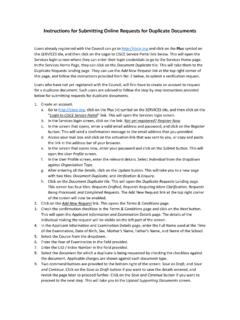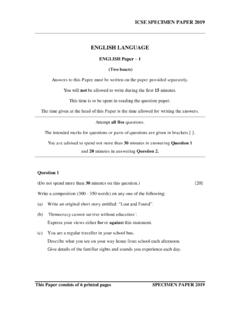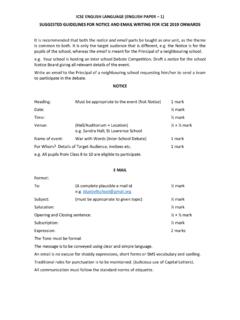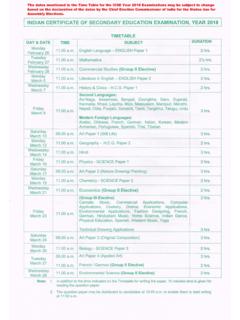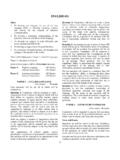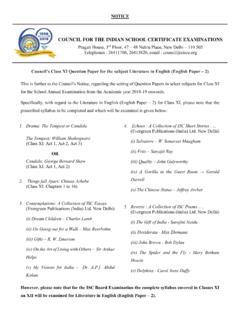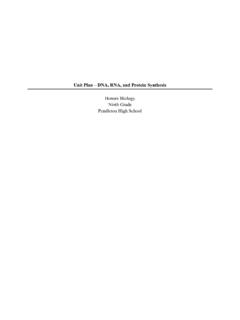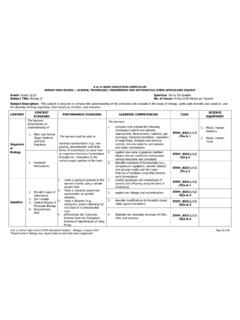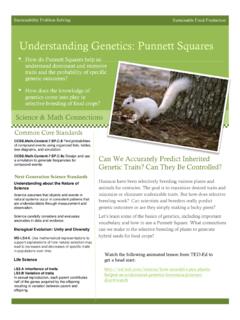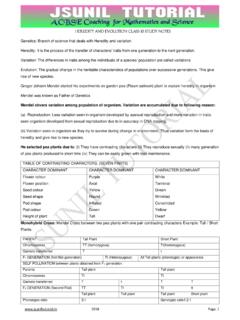Transcription of BIOLOGY
1 1 BIOLOGY (863) CLASS XII There will be two papers in the subject: Paper I: Theory: 3 hours .. 70 marks . Paper II: Practical: 3 hours .. 15 marks Project Work .. 10 marks Practical File .. 5 marks PAPER I- THEORY: 70 Marks There will be no overall choice in the paper. Candidates will be required to answer all questions. Internal choice will be available in two questions of 2 marks each, two questions of 3 marks each and all the three questions of 5 marks each. S. No. UNIT TOTAL WEIGHTAGE 1. Reproduction 16 Marks 2. Genetics and evolution 15 Marks 3. BIOLOGY and Human Welfare 14 Marks 4. Biotechnology and its Applications 10 marks 5. Ecology and Environment 15 Marks TOTAL 70 Marks 2 PAPER I THEORY 70 Marks All structures (internal and external) are required to be taught along with diagrams.
2 1. Reproduction (i) Reproduction in Organisms Reproduction, a characteristic feature of all organisms for continuation of species; sexual reproduction. Definition of life span; life span of a few organisms (banana, rice, rose, banyan, butterfly, fruit fly, tortoise, crocodile, parrot, crow, elephant, dog, horse, and cow). Sexual reproduction: Plants definition, phases of life cycle (juvenile/vegetative, reproductive and senescence), unusual flowering phenomenon (bamboo and Strobilanthes kunthiana). Animals continuous and seasonal breeders (definition, differences and examples). Chromosome number in the cells of house fly, fruit fly, butterfly, human beings, rat, dog, maize, apple, onion, cat, rice, Ophioglossum.
3 (ii) Sexual reproduction in flowering plants Flower structure; development of male and female gametophytes; outbreeding devices; pollen-pistil interaction; double fertilization; post fertilization events - development of endosperm and embryo, development of seed and formation of fruit; special modes - apomixis, parthenocarpy, polyembryony; Significance of seed dispersal and fruit formation. Pre-fertilisation structures and events. Structure of microsporangium, of anther microsporogenesis, structure and development of pollen grain, viability of pollen grain, economic importance of pollen grain. Pistil structure of megasporangium ( of anatropous ovule), megasporogenesis, structure and development of female gametophyte.
4 Pollen-pistil interaction in terms of incompatibility/compatibility, events leading to fertilisation, definition of triple fusion and double fertilization, changes in the ovary and ovule for seed and fruit formation. Significance of double fertilization. Apomixis, polyembryony, parthenocarpy to be explained briefly. Significance of seed and fruit formation. Significance of dispersal of seeds. Post-fertilisation events - embryo formation (dicot); types of endosperm (cellular, nuclear and helobial); definition of perisperm. (iii) Human Reproduction Male and female reproductive systems; microscopic anatomy of testis and ovary; gametogenesis - spermatogenesis and oogenesis; menstrual cycle; fertilisation, embryo development upto blastocyst formation, implantation; pregnancy and placenta formation (elementary idea); parturition (elementary idea); lactation (elementary idea).
5 Organs of male and female reproductive system and their functions; internal structure of testis and ovary to be taught with the help of diagrams; gametogenesis- spermatogenesis (including spermiogenesis and spermiation) oogenesis; hormonal control of gametogenesis, structure of sperm and mature ovum, menstrual cycle - different phases and hormone action, differences between oestrous and menstrual cycle, menarche and menopause, physico-chemical events during fertilisation, implantation, embryonic development up to blastocyst formation, important features of human embryonic development (formation of heart, limbs, digits, appearance of hair on head, eyelashes, separation of eye lids, external genital organs and first movement of foetus with reference to time period) placenta and its functions.
6 Parturition; lactation hormonal control and importance. (iv) Reproductive Health Need for reproductive health and prevention of Sexually Transmitted Diseases (STDs); birth control - need and methods, contraception and medical termination of pregnancy (MTP); amniocentesis; infertility and assisted reproductive technologies - IVF, ZIFT, GIFT (elementary idea for general awareness). Definition of reproductive health, programs of reproductive health (family 3 planning, RCH), population explosion - role of government in controlling the population, contraceptives methods and their methods of action (natural-periodic abstinence, withdrawal or coitus interruptus, lactational amenorrhea; artificial barriers, IUDs, oral pills, implants and surgical methods, definition of medical termination of pregnancy (MTP) and reasons for it; causes of infertility.)
7 Amniocentesis and its role in detecting genetic defects. Assisted reproductive technologies: IVF, IUT, ZIFT, ICSI, GIFT, AI, IUI. - definition and application only. Causes, symptoms and methods of prevention of sexually transmitted diseases (gonorrhoea, syphilis, genital herpes, chlamydiasis, genital warts, trichomoniasis, hepatitis- B, AIDS). 2. Genetics and evolution (i) Principles of inheritance and variation heredity : Mendelian inheritance; deviations from Mendelism - incomplete dominance, co-dominance, multiple alleles and inheritance of blood groups, pleiotropy; elementary idea of polygenic inheritance; chromosomal theory of inheritance; chromosomes and genes; sex determination - in humans, fruit fly, birds and honey bee; linkage and crossing over; mutation; sex linked inheritance - haemophilia, colour blindness; Mendelian disorders in humans; chromosomal disorders in humans.
8 Explanation of the term heredity ; Mendel's Principles of inheritance; reasons for Mendel's success; back cross and test cross, Mendelism to be taught with simple examples using Punnett square. Incomplete dominance with examples from plants (snapdragon - Antirrhinum) and co-dominance (inheritance of human blood groups), multiple alleles blood groups, polygenic inheritance with one example of inheritance of skin colour in humans (students should be taught examples from human genetics through pedigree charts. They should be able to interpret the patterns of inheritance by analysis of pedigree chart).
9 Biological importance of Mendelism. Pleiotropy with reference to the example of starch synthesis in pea seeds. Chromosomal theory of inheritance; autosomes and sex chromosomes (sex determination in humans, fruit fly, birds, honey bees and grasshopper), sex-linked inheritance - with reference to Drosophila (colour of body-yellow and brown; and colour of eyes-red and white), and man (haemophilia and colour blindness), definition and significance of linkage and crossing over. Mutation: spontaneous, induced, gene (point transition, transversion and frame-shift); chromosomal aberration: euploidy and aneuploidy; human genetic disorders: phenylketonuria, thalassaemia, colour blindness, sickle cell anaemia; chromosomal disorders: Down s syndrome, Klinefelter s syndrome, Turner s syndrome.
10 (ii) Molecular basis of Inheritance Search for genetic material and DNA as genetic material; structure of DNA and RNA; DNA packaging; DNA replication; central dogma; transcription, genetic code, translation; gene expression and regulation - lac operon; human genome project; DNA fingerprinting. Structure of eukaryotic chromosomes with reference to nucleosome; properties of genes such as ability to replicate, chemical stability, mutability and inheritability. Search for DNA as genetic material - Griffith s experiment, Hershey and Chase s experiment, Avery, McLeod and McCarty s experiment; double helical model of DNA (contributions of Meischer, Watson and Crick, Wilkins, Franklin and Chargaff); Differences between DNA and RNA; types of RNA (tRNA, mRNA and rRNA, snRNA, hnRNA); central dogma concept only; reverse transcription (basic idea only), Meselson and Stahl s experiment, replication of DNA (role of enzymes, namely DNA polymerase and ligase), transcription, post-transcriptional processing in eukaryotes (splicing, capping and tailing).
